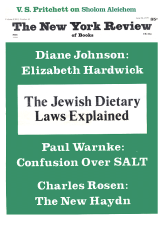In response to:
The Return of Ruskin from the January 25, 1979 issue
To the Editors:
Diane Johnson in her review of several books on John Ruskin (NYR, January 25) claims that Ruskin’s “…attempts to formulate aesthetic theories concerning color were original….” and “Another contribution of Ruskin’s is to attempt to bring color into the discussion of architecture, which is conventionally treated, now as in the nineteenth century, as if it occurred in black and white….”
The rediscovery of color in both ancient and contemporary architecture was in fact encouraged by the increasingly “naturalistic” way of seeing in the early nineteenth century. This development began long before Ruskin’s interest in the subject. Ms. Johnson might start with David Van Zanten’s The Architectural Polychromy of the 1830’s (Garland, 1977).
As far as the notion of functionalism in architecture is concerned, it cannot be assumed that such ideas refer back to Ruskinian theories. Lodoli’s and Laugier’s architectural treatises, as well as Bentham’s political theory had all contributed much earlier and more directly to an interest in the function and purpose of architecture, eventually replacing the older ideal of harmony.
Rosemarie Haag Bletter
Department of Art History and Archaeology
Columbia University
New York City
Diane Johnson replies:
I’m not entirely sure I understand Professor Haag Bletter’s point. She appears to think that I, or John Unrau, whose Looking at Architecture with Ruskin was one of several books I was reviewing, have suggested that Ruskin founded functionalism, when what I said was something closer to the opposite. The discussion was about Ruskin’s view that the working conditions under which buildings were built should influence our judgment of their value and beauty. He was of course horrified by industrialism, the assembly line and so on. My remark was that “his ideas on the relation of building to public morality were taken up, in quite elaborate disguises, chiefly that of functionalism to begin with, but are even more evident now in the rhetoric of a new architecture that wants doors ‘to celebrate the entrance experience’….” While acknowledging that this Ruskinian moral view does turn up in functionalist discussions—Quentin Bell mentions Muthesius and Vandervelde in this connection—I meant to suggest that Ruskin’s ideas are more directly sympathetic to post-modern architecture, that is, to those in reaction to the Bauhaus. Similarly, my statement, that Ruskin’s “ideas about the creative potential of each workman greatly influenced the arts and crafts movement, which in its turn influenced modern architecture,” is a true statement, but not a statement about architectural style.
Professor Haag Bletter says that “the rediscovery of color in both ancient and contemporary architecture was in fact encouraged by the increasingly ‘naturalistic’ way of seeing in the early nineteenth century,” which no doubt explains why Ruskin came to an interest in it. I don’t really see why Ruskin can’t have had original ideas on subjects that were concerning other people at the same time. Doesn’t it usually happen with ideas, however original, that they were there in the air somewhere? If her objection was to my saying that architecture is conventionally discussed as if it occurred in black and white, I should point out that David Van Zanten’s The Architectural Polychromy of the 1830’s which Professor Haag Bletter suggested I read, and which I have now read, was written as recently as 1968 when, as Van Zanten says, “proving the very existence of ‘the polychromy of the 1830’s’…seemed a considerable accomplishment.” This hardly suggests that architectural polychromy has been a matter of constant discussion since Ruskin’s day.
However, Van Zanten’s is an interesting book, particularly for its references to theorists of color, in particular M.E. Chevreul (De la loi de contraste simultané des couleurs, Paris, 1839). Although I find no evidence that Ruskin read Chevreul, he could have. Unrau notes that Ruskin studied the notebooks of painters, hoping to find theories about color. Van Zanten also notes the 1819 publication of the discovery of the kaleidoscope, which stimulated thinking and discussions about color, and with which Ruskin would certainly have been familiar. Ruskin was notably bad about acknowledging the influence of others on his own thinking.
This Issue
June 14, 1979



